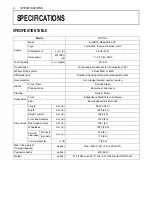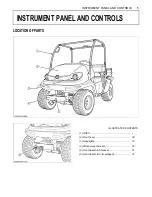
3
SAFE OPERATION
(2) Driving forward out of a ditch, mired condition or
up a steep slope increases the risk of a vehicle to
be upset backward. Always back out of these
situations. Extra caution is required with four-
wheel drive mode because the increased traction
can give the operator false confidence in the
vehicle's ability to climb slopes.
(3) Keep all movement on slopes slow and gradual.
Do not make sudden changes in speed or
direction.
C
Operation in inclement conditions
1. Only operate during daylight or with good artificial
light.
2. Operate vehicle in an open, unobstructed area.
3. Use helmet and/or protective gear for certain
operating conditions.
4. Reduce speed according to trail, terrain and visibility
conditions.
5. Never drive exceeding the limit of visibility. Slow down
near crest of hill until getting a clear view of the other
side.
6. Stay alert for holes, rocks and other hidden hazards in
the terrain.
7. Never cross any body of water where depth may be
unknown to the operator (Deep water is considered
anything above the bottom edge of the axle cap).
Choose a course within the waterway where both
banks have a gradual incline. Cross at a point known
to be safe.
C
Driving the vehicle at high speeds
1. Check the front wheel engagement. The braking
characteristics are different between two and four
wheel drive. Be aware of the difference and use
carefully.
2. Always slow the vehicle down before turning. Turning
at high speed may tip the vehicle over.
3. Turn the headlights on.
4. Drive at speeds that allow you to maintain control at all
times.
5. Do not apply the differential lock while traveling at high
speeds. The vehicle may run out of control.
6. Avoid sudden motions of the steering wheel as they
can lead to a dangerous loss of stability. The risk is
especially great when the vehicle is traveling at high
speeds.
C
Other miscellaneous
1. Clean platform if dirty and remove any debris from
around foot controls.
2. Always keep both hands on the steering wheel.
3. Always keep arms and legs inside the operating
compartment.
4. Never operate the vehicle while standing.
5. Do not tow a cart with any riders on it.
6. Never attempt wheelies, jumps or other stunts.
1. No riders in cargo bed or anywhere else.
2. Do not overload vehicle. Securely anchor all loads.
3. Be sure load is evenly distributed.
4. Reduce cargo capacity when operating on rough or
hilly terrain.
5. Balance loads evenly and secure them. Braking could
shift the load and affect vehicle stability.
6. Never operate vehicle with the cargo bed raised.
7. Operate cargo bed dump with vehicle stationary and
parking brake locked. Do not dump while moving.
8. Operate the cargo bed dump on level ground only.
9. Do not place hands or body under the cargo bed when
lowering bed.
1. Lower all implements to the ground, place all control
levers in their neutral positions, set the parking brake,
stop the engine, and remove the key.
2. Make sure that the vehicle has come to a complete
stop before dismounting.
3. Avoid parking on steep slopes, if possible park on flat
ground, if not, park across a slope, always with
attachment on the ground.
1. Disengage power to attachment(s) when transporting
or not in use.
2. Do not tow this vehicle. Use a suitable truck or trailer
when transporting on public roads.
3. Use extra care when loading or unloading the vehicle
into a trailer or truck.
3. HAULING LOADS IN THE CARGO BED
4. PARKING THE VEHICLE
(1) Parking brake lever
5. TRANSPORTING
Summary of Contents for RTV500
Page 13: ...5 SAFE OPERATION 1 Cardboard 2 Hydraulic line 3 Magnifying glass...
Page 14: ...SAFE OPERATION 6 7 DANGER WARNING AND CAUTION LABELS...
Page 15: ...7 SAFE OPERATION...
Page 16: ...SAFE OPERATION 8...
Page 18: ......












































